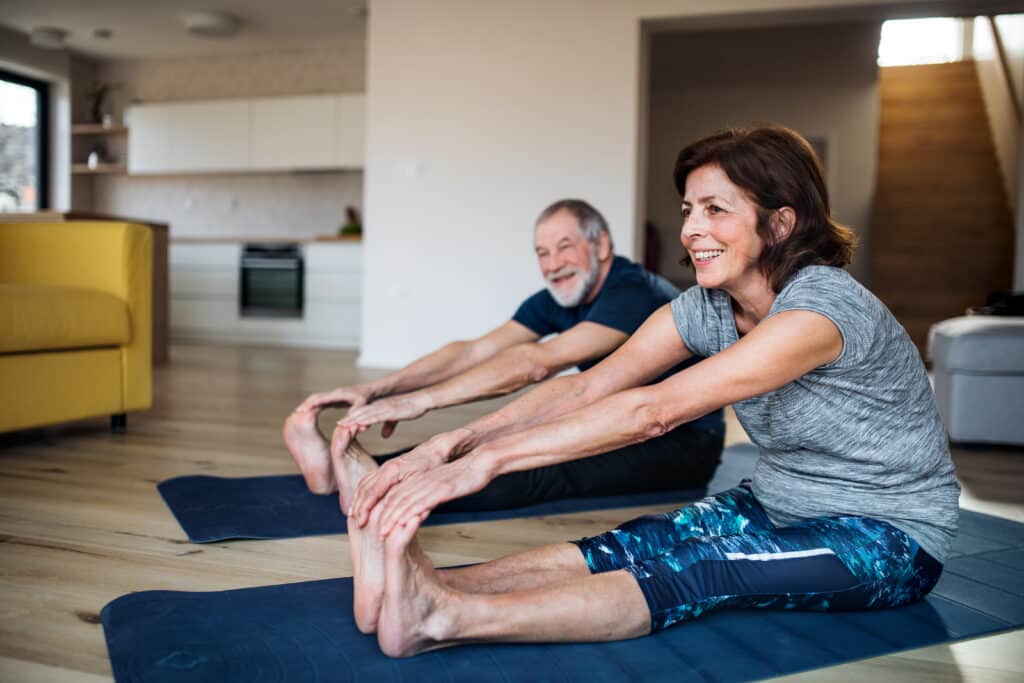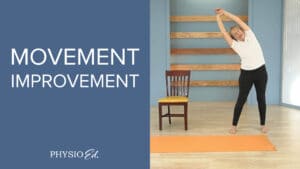As a trainer and health coach, I’ve witnessed firsthand the transformative power of regular exercise. It’s a key player in maintaining a healthy lifestyle, helping to keep your weight in check and warding off a host of diseases, such as heart disease, diabetes, and even cancer.
Beyond physical health, incorporating exercise into daily life is pivotal in bolstering mental well-being, fortifying bones and muscles, and enhancing longevity.
But making exercise a daily habit can seem challenging, particularly for busy seniors. Roadblocks can range from time constraints and dwindling motivation to physical limitations and fear of injury. But I’m here to tell you that these hurdles are manageable.
Table of Contents
- Exploring the Health Rewards of Consistent Exercise
- Mental Health Benefits of Regular Exercise
- Maximizing Daily Activities for Enhanced Physical Exercise
- Integrating Exercise into Your Work Routine
- Incorporating Structured Exercise into Your Daily Routine
- Creating a Routine and Sticking to It
- Navigating Challenges on the Path to Regular Exercise
- Tackling Physical Limitations
- Key Takeaways
You can seamlessly integrate exercise into your daily routine with the proper guidance and a tailored approach. In this article, we’ll delve into the myriad benefits of regular exercise, explore older adults’ unique challenges, and provide practical tips to help you make exercise a regular part of your life.
Remember, the goal here is not to become an Olympic athlete overnight but to make small, sustainable changes that can significantly improve your health and quality of life. So, let’s get started on this journey to a healthier, happier you!
Exploring the Health Rewards of Consistent Exercise

Amplifying Cardiovascular Health through Physical Activity
Consistent exercise is a gift to your heart. The American Heart Association affirms that physical activity can notably diminish the risk of heart disease, the top cause of death worldwide.1
Your heart is a muscle, and just like your biceps or triceps, it needs regular exercise to stay fit. When you exercise, your heart pumps more blood, essentially giving your heart a workout. This process strengthens your heart, making it more efficient.
A stronger heart translates to less strain during exercise and daily activities and a reduced risk of heart disease.
Boosting the Musculoskeletal System through Exercise
Exercise is not solely about shedding pounds or sculpting muscles; it’s also vital for fortifying your bones and joints.
Studies have shown that weight-bearing exercises, like walking or weight lifting, can enhance bone density. This helps to reduce the risk of osteoporosis, a condition that makes bones weak and brittle.2
For active adults, exercise is a long-term investment in your future self. The more you deposit now in the form of exercise, the more you’ll be able to withdraw later in strength and agility. This will help you maintain an active, independent lifestyle as you age.
Regular exercise helps you stay strong and agile, even in later years. Now that we’ve explored the physical benefits of exercise, let’s dive into the mental and emotional rewards of staying active.
Mental Health Benefits of Regular Exercise

Alleviating Stress the Natural Way
Exercise isn’t just a boon for your physical health. It’s also a potent stress-buster.
When you engage in physical activity, your body releases endorphins, often called “feel-good hormones.” These endorphins interact with receptors in your brain, reducing your perception of pain and discomfort.
At the same time, they trigger a positive sensation in the body, akin to the effects of morphine. Imagine it as a natural high that helps you unwind, relax, and tackle stress more effectively.
Over time, exercise also lowers the body’s stress hormones, like cortisol, contributing to a sense of calm and well-being. This especially benefits older adults, as stress can exacerbate age-related health issues like heart disease and high blood pressure.
Enhancing Mood and Mental Clarity: A Brain-Boosting Strategy
Regular physical activity has been shown to uplift mood and enhance mental clarity. A comprehensive study published in the Journal of Clinical Psychiatry found that regular physical activity can help alleviate symptoms of depression and anxiety, common mental health issues among older adults.3
Furthermore, exercise increases blood flow to the brain, significantly improving focus and cognitive function. This is particularly relevant for active older adults, as cognitive decline is a common concern with aging.
Not only does it make you feel happier and more positive, but exercise also makes you mentally sharper and more focused!
Maximizing Daily Activities for Enhanced Physical Exercise

Turning Household Tasks into Exercise Opportunities
Incorporating physical activity into your daily routine doesn’t have to be a daunting task. In fact, it can be as simple as transforming your regular household chores into exercise opportunities.
For instance, sweeping, mopping, or vacuuming are not just chores but can also serve as excellent cardiovascular workouts. These activities engage your arm and leg muscles and, when performed briskly, can elevate your heart rate, promoting better heart health.
Similarly, gardening tasks such as weeding or raking leaves can be a good workout. These activities engage your core muscles and improve your flexibility, crucial for maintaining balance and preventing falls, especially for active older adults.
The key is keeping a steady pace and consciously engaging your muscles, turning a mundane task into an effective workout.
Making TV Time More Active
Contrary to popular belief, watching TV doesn’t have to be passive. You can perform simple exercises like squats, lunges, or jumping jacks during commercial breaks. These exercises can help strengthen your leg muscles and improve your cardiovascular health.
If you’re up for a challenge, try doing a plank for a commercial break. This exercise engages your core muscles, which is essential for maintaining good posture and reducing back pain.
This method can help you stay active while making your TV time more productive and healthy.
Integrating Exercise into Your Work Routine

Millions of people spend a good portion of their day seated while working, whether it be driving or working at a desk. Unfortunately, sitting too much has been associated with numerous health issues across many age groups.
But building short bouts of exercise into your workday may be easier than you think. Here are a couple of simple ways to get a quick energy boost while you’re on the clock.
Opting for the Stairs
If your workplace or home has multiple floors, taking the stairs instead of the elevator can be a great way to sneak in some exercise.
Climbing stairs engages your leg muscles, strengthens your core, and increases your heart rate, making it a comprehensive mini-workout.
Start by taking the stairs once a day and gradually increase the frequency as your stamina improves. This simple change can have a significant impact on your overall fitness levels.
Desk Exercises for Better Health
Sitting for long periods can lead to stiffness and discomfort, which is particularly challenging for seniors.
To counteract this, try incorporating some simple desk exercises into your routine. For example, you can do seated leg raises to engage your core and lower body or shoulder rolls to relieve tension in your upper body. These exercises can help improve your flexibility and reduce the risk of muscle strain.
Additionally, standing up and stretching every hour can help improve your flexibility and reduce the risk of muscle strain. This simple habit can go a long way in promoting better health and well-being.
Every bit of movement counts towards improving your health. Incorporating these small changes into your daily routine can significantly impact your overall health and well-being.
Incorporating Structured Exercise into Your Daily Routine

Choosing the Right Exercise to Meet Your Needs & Interests
Exercise isn’t a one-size-fits-all solution. Discovering a form of physical activity that meets your health requirements and aligns with your passions is crucial.
For example, if you’re an outdoor enthusiast, you might find activities like hiking or cycling more enjoyable than indoor gym workouts. Alternatively, group exercises like Zumba or aerobics could be your preferred choice if you thrive in social environments.
The key is to find an activity you love, as this increases your likelihood of maintaining a regular exercise routine.
Consider Your Physical Condition
Your current physical condition plays a significant role in determining the most suitable exercise for you. Suppose you’re an active older person with joint issues. In that case, low-impact exercises like swimming or yoga might benefit you more than high-impact activities like running or skipping rope.
On the other hand, if you’re in good health and looking to enhance your cardiovascular fitness, more vigorous exercises could be appropriate. It’s always advisable to consult with your healthcare provider or a physical therapist before embarking on any new exercise regimen.
Creating a Routine and Sticking to It

Setting Realistic Goals
The foundation of a successful exercise routine lies in setting achievable goals. Rather than setting a lofty goal like running a marathon in a month, start with smaller, more manageable targets like walking for 30 minutes daily.
As your fitness level improves, you can gradually increase the intensity and duration of your workouts. Remember, the fitness journey is a marathon, not a sprint. It’s about making steady progress over time.
Tracking Your Progress
Monitoring your progress can serve as a powerful motivator. Consider using a fitness tracker or maintaining a simple journal to record your workouts and observe improvements over time. Celebrate your milestones, no matter how small they may seem. Every step forward is a step towards better health.
As a trainer, I can’t stress enough the importance of consistency in your exercise routine. It’s not about how hard you can push yourself in a single workout but about incorporating regular physical activity into your daily life.
Navigating Challenges on the Path to Regular Exercise

Addressing Time Constraints
In the hustle and bustle of daily life, carving out time for exercise can often feel akin to trying to extract juice from a dried fruit. However, rest assured, there are practical strategies to integrate fitness into your routine seamlessly.
While long, time-consuming workouts might not be attainable, I encourage you to consider the small ways to incorporate activity into your schedule, like walking to nearby appointments instead of driving or taking short breaks to move your body.
Here are a couple of strategies to consider:
Elevating Exercise to a Must-Do Activity
The initial step towards incorporating regular exercise into your life is to perceive it not as an extra but as an integral part of your daily schedule.
Just as you wouldn’t neglect a meal or a scheduled doctor’s visit, exercise should be treated equally. This shift in perspective can be transformative. It’s not about “finding” time for exercise. It’s about “creating” time.
Budget time in your to-do list specifically for your preferred activity rather than trying to fit it in around other obligations.
Embracing Short yet Regular Workouts
Avoid the misconception that it’s not worth the effort if you can’t allocate a full hour to exercise. Short bouts of physical activity, even just 10 minutes at a time, can accumulate and yield significant health benefits.
A study published in the Journal of the American Heart Association asserts that even brief periods of movement, as short as a minute, can enhance cardiovascular health.1
If you’d like to work out for a full hour daily, try breaking that hour up into ten minute chunks throughout your day.
Tackling Physical Limitations
Physical limitations are often a formidable barrier on your path to regular exercise. However, they need not deter you. There are viable ways to adapt and overcome these challenges.
Adapting Exercises to Your Needs
Every exercise can be tailored to accommodate physical limitations, and many activities can be adapted to be more approachable. Scaled exercises are a hallmark of physical therapy and exercise physiology. With proper guidance, virtually any exercise can be simplified to suit your needs.
For example, if knee issues are a concern, you might replace squats with seated leg extensions. If you don’t feel like you can do a pushup on the floor, try doing one against the edge of a countertop or even a wall.
Or, rather than using heavy weights while doing a specific exercise, try it without weights first. Virtually any exercise can be done with low or no weight other than the weight of your body if needed.
The essential thing is to tune into your body’s signals, adjust your activities accordingly, and don’t do too much too soon.
Seeking Professional Guidance
If you need more guidance about how to adapt exercises or which activities are safe, seek professional advice. A physical therapist, a qualified trainer, or a coach can provide personalized guidance based on your needs and limitations.
The benefits of regular exercise extend far beyond physical fitness. It can boost your mood, improve your sleep, and even enhance your cognitive function. Small, consistent steps can lead to substantial changes over time.
By taking the time to consider your needs, interests, energy, and schedule, you can make exercise a positive and enjoyable part of your everyday routine. Incorporating exercise into your daily life can be a breeze with some planning, care, and patience.
Key Takeaways
- Regular exercise can significantly improve both physical and mental health, reducing the risk of diseases like heart disease, diabetes, and osteoporosis while also boosting mood and mental clarity.
- Incorporating exercise into daily routines, such as household chores, TV time, or work routines, can make staying active more manageable and enjoyable.
- Choosing an exercise that aligns with personal passions and physical conditions can increase the likelihood of maintaining a regular exercise routine.
- Setting realistic goals and tracking progress can be powerful motivators on the journey to regular exercise.
- Time constraints and physical limitations can be overcome with the right strategies, such as viewing exercise as a must-do activity and adapting exercises to accommodate physical limitations.
References
- American Heart Association. (2019). Physical Activity Improves Quality of Life. Retrieved from https://www.heart.org/en/healthy-living/fitness/fitness-basics/aha-recs-for-physical-activity-in-adults
- Martyn-St James, M., Carroll, S. (2019). Effects of different impact exercise modalities on bone mineral density in premenopausal women: a meta-analysis. Journal of Bone and Mineral Research, 34(3), 468-482. doi: 10.1002/jbmr.3626
- Schuch, F.B., Vancampfort, D., Firth, J., Rosenbaum, S., Ward, P.B., Silva, E.S., Hallgren, M., Ponce De Leon, A., Dunn, A.L., Deslandes, A.C., Fleck, M.P., Carvalho, A.F., Stubbs, B. (2019). Physical Activity and Incident Depression: A Meta-Analysis of Prospective Cohort Studies. Journal of Clinical Psychiatry, 80(4). doi: 10.4088/JCP.18r12466
- Saint-Maurice, P.F., Troiano, R.P., Matthews, C.E., Kraus, W.E. (2019). Moderate‐to‐Vigorous Physical Activity and All‐Cause Mortality: Do Bouts Matter? Journal of the American Heart Association, 8(6). doi: 10.1161/JAHA.117.007678
- National Institute on Aging. (2019). Exercise and Physical Activity. Retrieved from https://www.nia.nih.gov/health/exercise-physical-activity
- American Physical Therapy Association. (2019). Physical Therapist’s Guide to Healthy Aging. Retrieved from https://www.choosept.com/resources/detail/physical-therapist-s-guide-to-healthy-aging
- Harvard Health Publishing. (2019). The top 5 benefits of cycling. Retrieved from https://www.health.harvard.edu/staying-healthy/the-top-5-benefits-of-cycling







